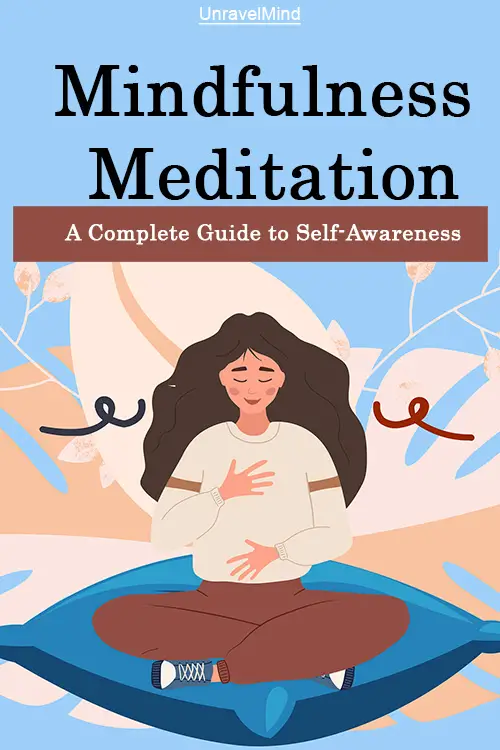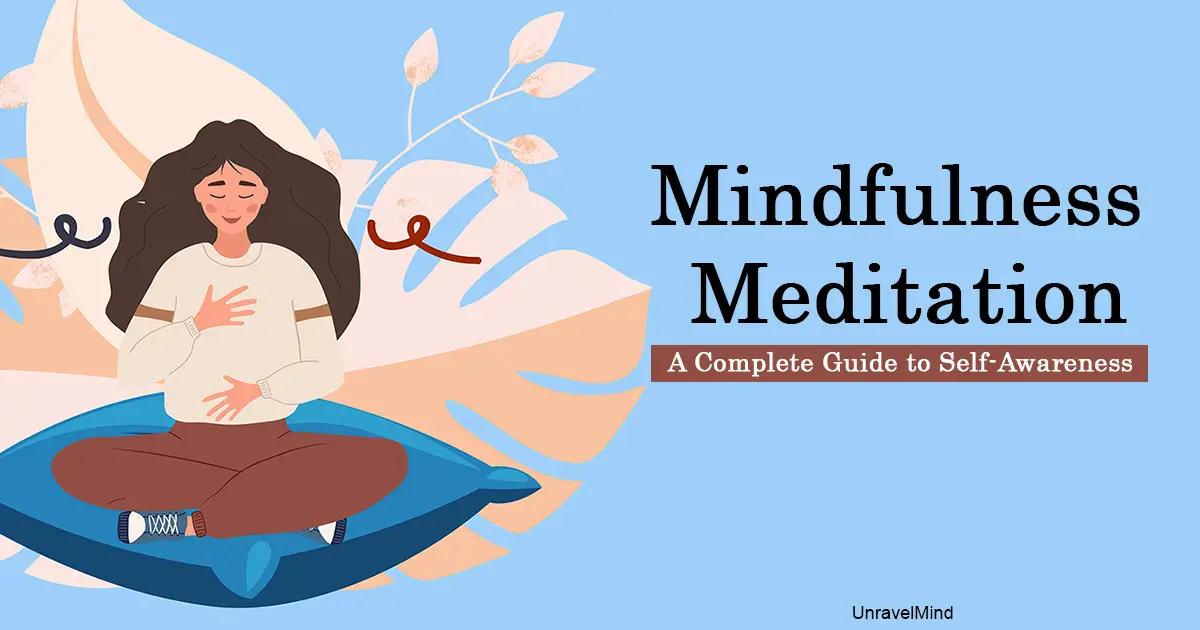Most of us have heard about or even done some kind of meditation in life. It is an ancient practice. It is also the most common one when someone talks about spiritual practice. However, we may wonder if scientific research ever backed the effectiveness of meditation. Interestingly, there is one method of meditation that does have this backing. It is known as mindfulness meditation.
What Does ‘Mindfulness’ Mean?
We have to understand what mindfulness means before we get into mindfulness meditation. As you may have guessed by reading the word, it is related to ‘being mindful’ or aware. It is all about being aware of the present moment with our entire focus on solely that and nothing else. It lets us know about our sensations, feelings, and thoughts. Becoming aware of these aspects of ourselves, in turn, gives us the opportunity to view them without bias and finally, accept them.
Mindfulness meditation is, thus, a kind of meditation where we become aware of all these aspects through the act of calming ourselves down and slowing our thoughts. The latter part is, after all, the main purpose of meditation.
There are two main components of mindfulness meditation. The first is about attention. This part involves us thinking about our experiences while we try to take in the present moment in time. Usually, we do this by focusing on our breath and our thoughts. We also focus on our bodily sensations, and our emotions at that moment in time to complete the experience.
The second component of this practice involves acceptance. If we take some time out for ourselves and close our eyes, we can easily experience the first component. However, an important part of mindfulness meditation is letting go of our judgments. We must not judge ourselves while we observe all these sensations and emotions. We have to understand that practicing this kind of meditation is not about reaching a conclusion for these thoughts. It’s only about noting them down, and then letting them go from your mind.
How To Practice Mindfulness Meditation
Mindfulness meditation is perhaps the easiest form of meditation available. There are paid services and classes that can help you with the experiences. On the other hand, you can also start with the meditation practice by yourself. The results will not be any different. We will cover both these kinds of methods briefly.
For paid services, there are two intervention types that have the most amount of scientific research backing them. The first is MBSR or Mindfulness-bases stress reduction. This therapy is usually carried out through group classes held every week as well as mindfulness exercises that participants must practice on their own at home every day. It usually lasts about 8 weeks. The objective is to use meditation and yoga to increase mindfulness.
The second one is a more curative intervention. It is known as MBCT or Mindfulness-based cognitive therapy. It adds CBT or cognitive behavioral therapy to the MBSR. It is used as a treatment for depressed patients and depression in general.
Mindfulness Meditation’s Impact
So what exactly does this moment of increased awareness do for us? It may surprise you: mindfulness meditation has emotional as well as physical benefits. The most prominent of them is stress reduction. MBSR therapy (mentioned earlier) has been proven to reduce stress, provided the practitioner is, more or less, physically healthy. Research has also shown the practice help with chronic pain, and anxiety, along with depression.
The second benefit, surprisingly, is that it reduces heart rate. No matter where or how you live, life today involves far too much stress daily. A study divided patients into two parts: one-half were assigned to mindfulness meditation classes held online. The other half were given traditional heart disease treatments. The research concluded that the patients who practiced mindfulness meditation had much lower heart rates. They also had a better performance when it came to cardiovascular capacity.
Thirdly, mindfulness meditation can also improve your immunity. Different research studied how much exercise helped with immunity compared to mindfulness. Once more, the conclusions said that the participants of the eight-week course on mindfulness showed better immune functionality than those that did regular exercise.
The final notable benefit is related to sleep. Not only does mindfulness meditation improve sleep, but it can also cure some disturbances in sleep.
The Working Behind Mindfulness Meditation
You must be wondering as to how such a simple meditation technique can have so many benefits. Well, scientists have also carried out research into the effects of mindfulness meditation. They think that the effectiveness comes from how the practice tones down how the human body responds to stress.
According to psychological scientists, mindfulness has been found to affect two different pathways of stress in our brains. Furthermore, they have also found that practice alters structures in our brain, as well as affects the activity in the parts that regulate our emotions and attention.
While reviewing meditation studies, researchers also found a curious effect. MBCT participants were less likely to give unhelpful emotional responses or show negative thoughts while facing stressful situations. They found strong evidence for this conclusion. Researchers also found moderate evidence of MBSR or MBCT participants focusing on the present more, and not worrying or thinking repeatedly about some negative experience or thought.
Practicing Mindfulness On Your Own
With the more group-oriented practices out of the way, let’s get into what you can do on your own. As with every kind of meditation, there is no need to be perfect. In fact, there is nothing called perfect meditation. All you need to do is simply start the process and do it diligently every day.
Find Your Comfort Place
The first step is the same as any other kind of meditation: get comfortable. You can sit in any place you like, be it a chair, the floor, or your bed. Then straighten your back, but take care not to stiffen up. Loose and comfortable clothing is ideal, otherwise, the tightness can be a distraction. However, this is just a recommendation, choose the clothing that you find the most comfortable.
There is an optional step here. You might want to have a timer on hand. Ideally, the alarm should be soft and gentle. There is no doubt that we all lead very busy lives and we can hardly afford to spend multiple hours meditating, as beneficial as it may be. However, time can also become a nagging and distracting thought. A timer will let you forget about time without any worries.
Moreover, you can meditate too much as well. After the meditation is over, you have to spend some time re-adjusting yourself to your physical environment. Be that as it may, if you can allocate even 5 minutes per day to meditation (as a start), it will do wonders. As you get more and more used to it, you can increase the time gradually.
Observe Your Thoughts, Nothing More, Nothing Less
Now, to get back to the process. After getting comfortable, and closing your eyes, focus on your breathing. Feel the air and rhythm of the air being inhaled and exhaled from your body. Feel all the changes that take place in your body with every breath: the belly rising, the sensation in your nostrils, and the change in the temperature of the air between when it goes in and when it goes out.
Once you are attuned to your breath, turn your attention toward your mind. Mindfulness meditation is not about stopping the flow of thoughts. It is about only witnessing them, without judgment or any reactions. When you encounter a thought, there is no need to suppress or ignore it. Let it flow. Observe it and make a mental note of it.
However, try not to flow along with it, keep yourself calm using your breath as the anchor point. You can think of the thoughts as clouds in the sky – floating along while changing shape, while you remain on the ground, simply looking at them and doing nothing more.
Take A Break
It is not easy to keep yourself grounded while looking at your thoughts. In fact, if it was that easy, a lot of our problems would not even exist. However, even during this meditation, you may realize that the thoughts are carrying you away further and further into hope, anxiety, fear, or worry. Instead, notice the place that the mind has reached, without judging it. Then, refocus on your breathing to find your way back.
There is no need to think that you did something wrong if this happens. In fact, one of the core meanings of mindfulness is having the ability to refocus on the present moment using your breathing! So, if you get lost and manage to find your way back, that is, in a way, mindfulness meditation.
Mindfulness Practices You Can Do Everyday
The practice of mindfulness is not just about meditation. Some of the more common chances for practicing mindfulness are very simple.
It can begin when you go to brush your teeth in the morning or at night. Focus on three sensations: your feet touching the floor, the movement of your arm, and the sensation of the toothbrush in your hand. Next up, while cleaning the dishes after a meal, feel the water (warm or cold) on your skin. See how the bubbles look and maybe you can also find some sort of music as the pans clunk at the sin’s bottom.
Similarly, while you are doing the laundry, you can observe, smell, and feel the clean clothes. You can also try to keep count of your breath while folding laundry to help you focus more. Another opportunity will be while you are in the driver’s seat of your car. Try to keep the music to a minimum, or at least something soothing. Do not grip the steering wheel too hard or too loosely. Then try to keep your mind to your and your car’s present space in time, whenever the mind wanders.
When you are exercising, try to focus on your breathing as well as the position of your feet, rather than mindlessly watching the television or listening to music. Finally, if you have kids, try to reach their level when you are tucking them in for the night. Interact with them while looking into their eyes. Try to listen to them more, instead of simply talking. Your relaxation will be the stimulus for your kids’ relaxation.
Frequently Asked Questions:
What are the basics of mindfulness?
The fundamental thought behind mindfulness is removing yourself from anytime apart from the present. Then, use that focus to know and feel your senses.
How do I practice Mindfulness Meditation?
Practicing mindfulness meditation is as easy as getting comfortable, and paying attention to every sensation and emotion in your body. Be observant about when and where your mind wanders, but also be kind towards the wandering.
What is the difference between Mindfulness and Meditation?
Mindfulness is a state where we are aware (or “mindful”) of everything around us and every bodily sensation. Meditation is an act of controlling the flow of thoughts so that we may have a calm mind.
Read more : 7 Types Of Self-care And Why You Should Practice All Of Them
Pin this article for later



